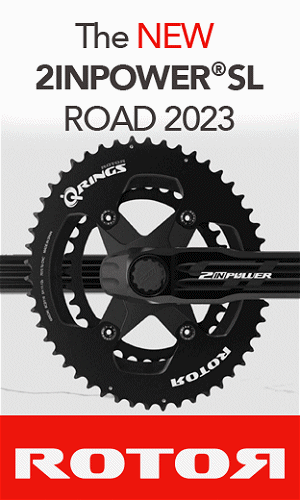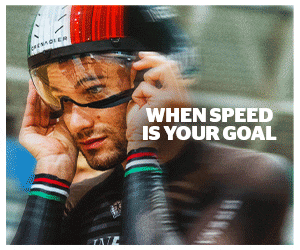So many champions are using them, Matt Bottrill, Michael Hutchinson, even a certain Yellow jersey in the Tour de France apparently — Osymetric Chainrings.
 |
Marginal Gains
Listening to an interview with Jens Voigt on ITV4, he talks about how Sky are making gains of one percent here and one percent there and when you get to 10 per cent say, that gives them (Sky) quite an advantage over their rivals. One product that more and more top riders are using are the Osymetric chainrings.
Jon at TrainSharp persuaded Bronwen Ewing to try them and using a 56 chainring, Bronwen claimed the Silver medal in the National 50 and 100 mile TT! They really work” says Jon and to help those with an interest in trying them, here is an FAQ on the Osymetric chainrings. They’re available from Trainsharp, sponsor of top team Ingear (and VeloUK) and Jon says TrainSharp is passionate about increasing bike performance through tried and tested coaching and training methods, correct bike position and correct equipment choices.
This philosophy of making marginal gains as Team Sky and Team GB do is something all riders can do with a bit of forethought. IE, marginal gains across both a riders training and the bike they use. Osymetric chainrings says Jon, have been scientifically proven to increase power by an average of 10%, increase speed and efficiencies by 10% and reduce lactic acid in the muscles by 12% (helping you recover much quicker for your next effort or training ride).
Matt Bottrill speaking to VeloUK earlier this year said them, “You have always have that forward stroke†he says. “Its feels like you are riding fixed and gives you that extra push when you are on the hills and stuff. It’s a big big advantage.â€
What is an Osymetric chainring?
The Osymetric chainring is not an oval or an ellipse chainring – it is unique patented twin cam (refers to two curves which are symmetrical about a single point) chainring which has been designed eliminate the “dead spot/weak spot†which is part of every cyclists pedal stroke due to the design of standard chainrings.
What type of events can Osymetrics be used in?
Initially Osymetrics came to prominence in time trials as the gains could be proven against the clock. Since then Osymetrics have been used on all types of bicycles and in all types of events (including Time Trials, Road Racing, Triathlons, Sportives, Mountain Biking, burning up your local ride etc.) from the Tour de France to local amateur events.
Riders using Osymetrics have medalled in the Olympics, World Championships, National Championships as well as victories in Grand tours stages. Osymetrics are UCI legal.
How does an Osymetric chainring work?
The push phase of the pedal stroke (between the 1 and 5 o’clock positions of the crank) is where the rider uses the strongest pedalling muscles and therefore produces the largest amount of power whereas the “deadspot†phase is where the rider produces the least amount of power. This deadspot happens to be where the weaker pedalling muscles come in to play. They have to work extra hard to try and keep the angular velocity going (speed through deadspot) and this in turn encourages more lactate to continue to build up over time.
The Osymetric chainring has a high and low cam profile (high gear and low gear). These two cams alter the effective gear ratio throughout the pedal stroke. The cams have been positioned so that the gear ratio is at its highest on the push phase and at its lowest on the “deadspot†phase.
For example, an Osymetric chainring marked 52 will give you a gear equivalent to a 56 toothed chainring on the push phase of the pedal stroke (where your muscles are at their strongest) and a gear equivalent to a 48 toothed chainring at the “deadspot†phase of the pedal stroke (where your muscles are weakest). Osymetric chainrings take advantage of your muscles when they are at their strongest ie pushing.
Remember what makes a gear feel large is the size of the deadspot area as you suffer with dragging the gear through the bottom and top dead centre. Compared to round rings, Osymetrics will produce more power for the same cadence.
Wiggins in the time trial in the Tour de France.
How much power can you expect to gain with Osymetric?
Power is the rate at which muscles produce energy and Watts is the term we use to express this energy. PowerMeters such as SRM’s can measure this power and give live feedback to the rider as well as storing this data for later studies. By using these PowerMeters, it has been shown that average riders gain an extra 10% of power at the cranks for the same physical effort. Laboratory and road tests have been carried out to quantify the benefits of Osymetrics including one where Christophe Moreau and Laurent Brochard rode a 30.5km route from Bourg St Maurice to the Val d ’Isere ski station. Comparing conventional round rings with the asymmetric chainrings, they both rode over a minute quicker with Osymetric chainrings.
When can I expect to gain this power?
The gain is apparent at low aerobic efforts although Osymetrics are most beneficial the closer you are to your personal anaerobic threshold. The harder you push the greater the power gains.
Can Osymetrics help reduce the build-up of Lactate?
Scientific studies have shown that riders produce up to 12% less lactate due to a significantly reduced strain on legs where the deadspot would lie with round rings. Trainsharp rider feedback confirms legs are less sore and stay stronger for longer when using Osymetric chainrings.
Will Osymetric affect my cadence?
Round rings do not have a constant cadence or angular velocity (speed at which crank turns) as they go fast then slow due to deadspot, this makes which make your legs struggle. Osymetrics profile is designed to match the muscles strength and ability, therefore angular velocity is kept constant. A few riders find a bit of choppiness in their cadence when riding at recovery level but soon adapt to this. However, even when fatigued, Osymetrics will not give you that pedalling square feeling which round rings can.
People have commented that the Osymetrics quickly throw you back into the power stroke similar to riding a fixed gear bike and actually “really feel roundâ€. There is no doubt that spinners and big gear pushers can equally benefit from using Osymetric rings. If you are still unsure, just look how smooth riders such as Bradley Wiggins and David Millar are when riding road races and time trials.
How long will it take me to get used to riding with Osymetric rings?
There will be an adaption phase however 95% of all cyclists get used to Osymetric rings in as little as an hour. Often less experienced cyclist instantly find Osymetric rings easier to use when compared to round rings as they do not need to struggle with or perfect their pedalling technique. This group of rider can see instant big efficiency gains simply by fitting Osymetrics.
Please note: your legs may feel a bit sore after the first few rides on Osymetric. This is purely because you are pulling in some other muscle groups and utilising the strong muscles more effectively.
What happens if I return to normal chain rings?
The majority of the feedback we receive tells us that riders find it harder when you go back to round rings (when riding spare bike for example). Initially, they feel they are pedalling squares and definitely notice a drop in power.
However, you may see a lot of the Sky team back on round rings to train as they are harder for the legs. For example Alex Dowsett rode round rings in the 2011 British Time Trial Championships and then reverted back to Osymetrics for the Time Trial in the Tour of Britain and beat Lars Boom in the process!
2011 TT Champs – Alex Dowsett
2011 Tour of Britain, Alex Dowsett.
Will Osymetrics affect the reading of my SRM PowerMeter?
No. The Osymetrics will not affect the live or stored data of SRM’s. The SRM PowerMeter is a very accurate scientific tool. They calculate power as: Torque, over and as an average per one pedal revolution. This means the power for the whole pedal revolution is displayed and stored and not portions of the revolution. The SRM’s will read more power because you are producing more power.
Do Osymetric chainrings require a special chain?
No, but we would recommend a good high quality chain such as a KMC 10 speed which can be purchased at TrainSharp’s on-line store.
Are Osymetric chainrings louder?
Initially you may notice the sound of the chain on the relatively flat portion of the ring is a little bit noisy. The rings will start to wear in after a few weeks of riding and get much quieter. As with all chainrings we advise you use a good quality chainlube and keep chain clean.
Why are Osymetric chainrings not used by all the Pro Tour Teams?
Professional cycling is mainly funded by sponsorship from big companies like Sky, frame manufacturers like Specialized, Pinarello and Cervelo and component manufacturers like Shimano, Campagnolo and Sram. Historically some riders have preferred to use other manufacturers’ equipment due to performance or sometimes financial gains.
Nowadays, due to conflicts with sponsors, most teams will not allow riders to use equipment unless the team is sponsored by said manufacturer. However some teams such as Sky, Cervelo, RadioShack will allow their riders to use certain pieces of equipment based on performance gains – it may be that the logo is still taped over though! Osymetrics have been ridden to victory and podiums at previous year’s editions of the Tour de France, Giro and Tour of Spain and this year’s Paris-Nice, the Tour of Romandie and the Criterium Du Dauphine.
Osymetric is a relatively small company and does not have the budget to sponsor big teams. You can be assured that all riders using Osymetrics in Pro Tour teams are using them for performance gains only.
Matt Bottrill with Osymetric chainring.
What BCD (Bolt Circle Diameter) Osymetric chainring should I buy?
The BCD (Bolt Circle Diameter) is the diameter of the chainring (measured in millimetres). Importantly the measurement is taken with the circumference passing through the centre of each chainring bolt (where chainring attaches to crank/spider arm) and not a measurement of the overall chainring circumference. Sometimes this is also called Pitch-Circle Diameter (PCD). Typically, road bike chainrings have three main BCD measurements depending on component manufacturer and whether the cranks are standard or compact.
Standard cranks with round rings are normally fitted with 39/53 toothed or 42/52t chainring combinations. At the time of writing all other major manufacturers except for Campagnolo (Shimano, SRAM, FSA, Rotor etc) use a BCD 130 on their standard cranksets. Campagnolo use a BCD of 135 on their standard cranks. Osymetrics can be used as single outer rings for time-trials etc.
Compact cranks with round rings use smaller chainrings (ie 34/50t combination) than standard cranksets. At the time of writing all major manufacturers except for Campagnolo (Shimano, SRAM, FSA, Rotor etc) use a BCD of 110 on their compact cranksets. Osymetric do not make chainrings for Campagnolo compact cranksets.
Do I have to buy Osymetric chainrings in pairs?
No. TrainSharp can supply Osymetrics chainrings as single items or as a pair in any combination.
Is it safe to use Osymetric chainrings?
Yes it is. Most cycling injuries are caused by poor positioning, poor pedalling techniques (due to the deadspot which round rings can cause) and overuse of weaker muscle groups. Studies have shown that Osymetric chainrings reduce the maximal forces on the knee by 7.5% compared to round rings. Riders also benefit from a more stable pedalling action due to the decreasing gear ratio at key areas where muscles are at their weakest.
Jean-Louis Talo (the inventor of Osymetric chainrings) states that you will see increased “long term muscle development†because Osymetric chainrings do not leave your legs in the same state of fatigue as round rings do. This means they will recover quicker and have less chance of succumbing to overuse injuries. TrainSharp riders have commented that long term nagging rear of leg injuries have disappeared when using Osymetrics.
Aren’t Osymetric chainrings expensive?
It is true that Osymetric chainrings are more expensive than most standard chainrings however their cost compares very favourably to other non standard chainrings and their performance gains are shown to be superior in many studies.
This study http://www.rouesartisanales.com/article-15505311.html shows that a Zipp 808 absorbs approximately 15w less power than a Mavic Askium at 50 km/h. Not many riders can average 50km/h and therefore achieve the said power gains.
A rider with a threshold power of 300 watts should expect to see an increase in power of between power 15- 45 watts when using Osymetric chainrings regardless of their road speed. Apart from tri-bars (which are not legal for many bike events) Osymetric chainrings are probably the most cost efficient way of improving your performance via equipment and component choice.
I have heard the chain does not shift as well between Osymetric chainrings?
We would agree shifting between the inner and outer ring and vice-versa is not as smooth as you would find with the top manufacturers standard rings, which are designed with pins and ramps to enhance shifting. However, as with all gears, once set correctly, Osymetrics do not significantly compromise gear shifting.
I have heard my chain will fall off more frequently when using Osymetrics.
Once the front changer has been set-up correctly and a chain catcher has been fitted, the chain should not derail anymore than it would when using standard round or oval rings. Osymetric chainrings are used by many riders in the Pro Road and Pro MTB pelotons, these environments test equipment to the maximum. There have been no outstanding issues with Osymetric chainrings.
Will Osymetrics work with electronic gears?
Yes Osymetrics will work with electronic gears.
Do I need to carry out any adjustments to my gears when fitting Osymetric chainrings?
Yes you will need to move and adjust the front changer.
Other Results on VeloUK (including reports containing results)
- RR Result: East Cleveland Classic
- Features, Reports, Results
- Crit Result: Thruxton Tuesday Series 2
- Crit Result: CDPP Sport Crit Series 1
- Crit Result: SACA Salt Ayre Series 1
- Crit Result: Portsmouth Evening Circuits 4
- Crit Result: Rowe & King Maindy 1
- Q&A: Charlie Abraham (Lee Valley Youth Junior Cycling Team)
- Events: SSSCCRRL Road Race League
- Youth Result: Isle of Man Youth League
- Youth Result: Lawford Youth Series (Curborough) #2
- Crit Result: Full Gas Summer Circuit Series #2
- Crit Result: Ride Flux Spring Crit series #2
- Youth Result: Maindy Flyers Freewheel League 1
- Ribble Collective: Ride More in ’24
- Crit Result: Tameside Cycling Development Circuit Races 1
- Crit Result: 2024 West Thames League 1
- Startlist: The Drummond Trophy
- TT Result: VTTA Surrey/Sussex 10 mile TT
- EVENTS: Proper Northern Road Races – Round 2 Oakenclough
- TTT Result: Scorton TTT
- TT Result: Manchester & District TTA 25m TT
- TT Result: Stowmarket & District CC 15m TT
- TT Result: Paceline RT Sporting TT
- TT Result: Hereford & District Wheelers 25m TT
- RR Result: Yorkshire RRL #1
- Crit Result: Scottish Student Cycling Criterium Championships
- Events: Dave Peck Memorial
- TT Result: Blaydon CC Two Up TT
- TT Result: Kent CA 10m TT
- TT Result: Wessex RC 24m TT
- TT Result: Easterley RC 25m TT
- TT Result: Cranbrook CC 10m TT
- TT Result: Penzance Wheelers 12.5m TT
- TT Result: Fife Century RC 25m TT
- TT Result: Bramley Wheelers 10m TT
- TT Result: Mid Shropshire Wheelers 25m TT
- Youth Result: Hog Hill GP (National Youth Series)
- RR Result: Velo Club Venta Spring Road Race
- News: Women’s Tour of Britain
- Crit Result: Ennerdale Season Openers 2
- RR Result: NCRA Handicap RR (week 5)
Other News on VeloUK
- Events: SSSCCRRL Road Race League
- Ribble Collective: Ride More in ’24
- Startlist: The Drummond Trophy
- EVENTS: Proper Northern Road Races – Round 2 Oakenclough
- Events: Dave Peck Memorial
- News: Women’s Tour of Britain
- Startlist: PB Performance Espoirs Road Race
- East Cleveland Classic: Saint Piran Team
- News: New kit for Ribble Rebellion Riders
- Events: Halesowen Friday Track Nights
- Team News: Ribble Rebellion off to the USA
- News: Pedal Club Lunch (March)
- Rider News: Winning start for Billy Ladle
- News: CiCLE Classic 2024
- Startlist: Stars of the SW Men’s U23 RR
- Startlist: Danum Trophy 2024 (Nat B)
- Startlists: London Dynamo Road Races
- Startlist: La Fleche Waltonne Road Races (BMCR)
- Meet Ribble HoloRider
- Startlists: East Cleveland Classic 2024
- Former Winners: Lincoln Grand Prix
- Chris Lawless Joins Saint Piran Team
- Paracycling Track Worlds Day 4
- Para CyclingWorlds Final Day
- Startlist: National Youth Circuit Series Rd 1
- Report/Result: Azets Spring Classic
- Startlists: RCR Fat Creations Road Races
- Startlist: Capernwray Road Race (March 31)
- Team Report: Fensham Howes MAS Design Junior Team
- Team Report: CiCLE Classic Junior Men
- RIDER REPORTS – Zoe Parker (Solihull CC)
- GB News: Two World Titles for GB at Para Worlds
- Team News: Alba Development Road Team
- News: British Road Champs Return to NE
- THIS WEEKEND: Peaks Two Day is Back!
- News: Laura Kenny Retires
- Team News: Lee Valley Youth Cycling Team
- 2024/25 CYCLO-CROSS CALENDAR
- Startlist: Cardiff Ajax CC 10 Mile TT
- Startlists: 16th Gifford Road Races (Scotland)


























